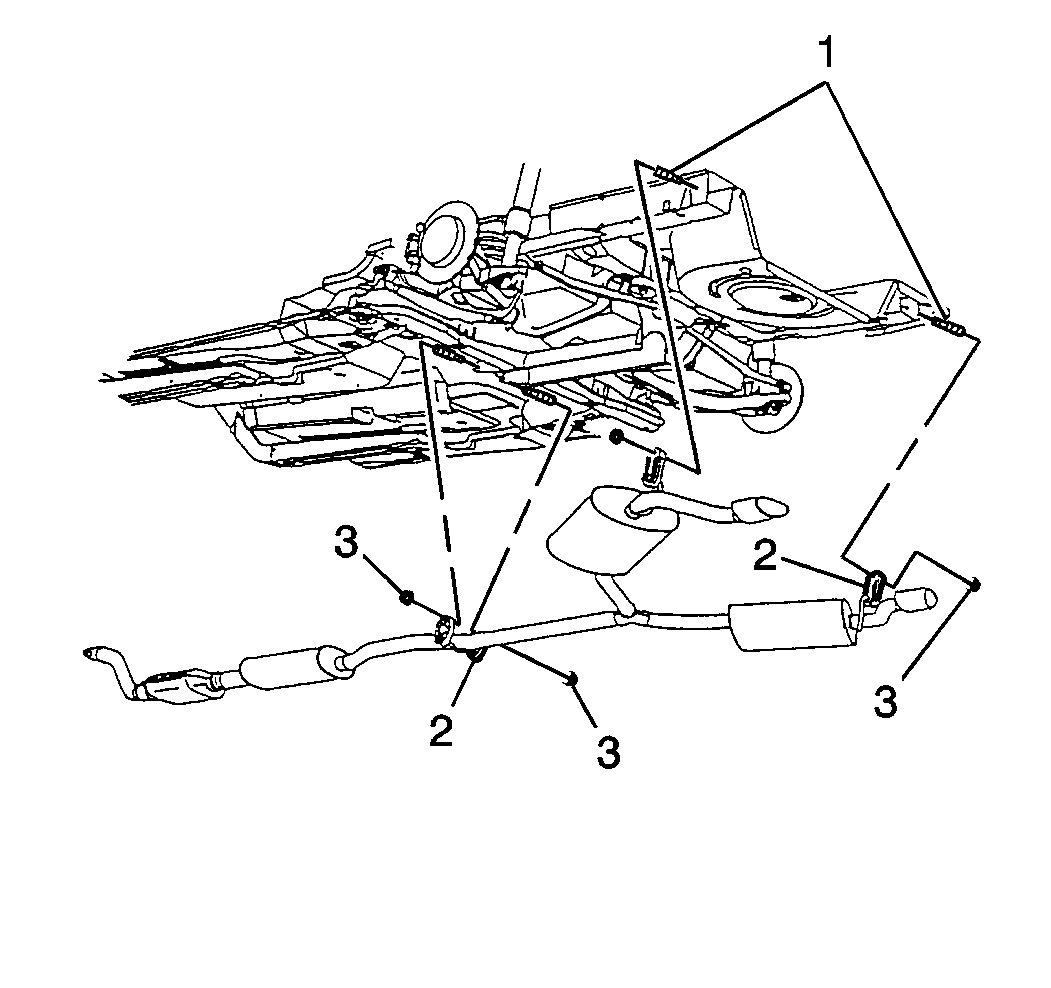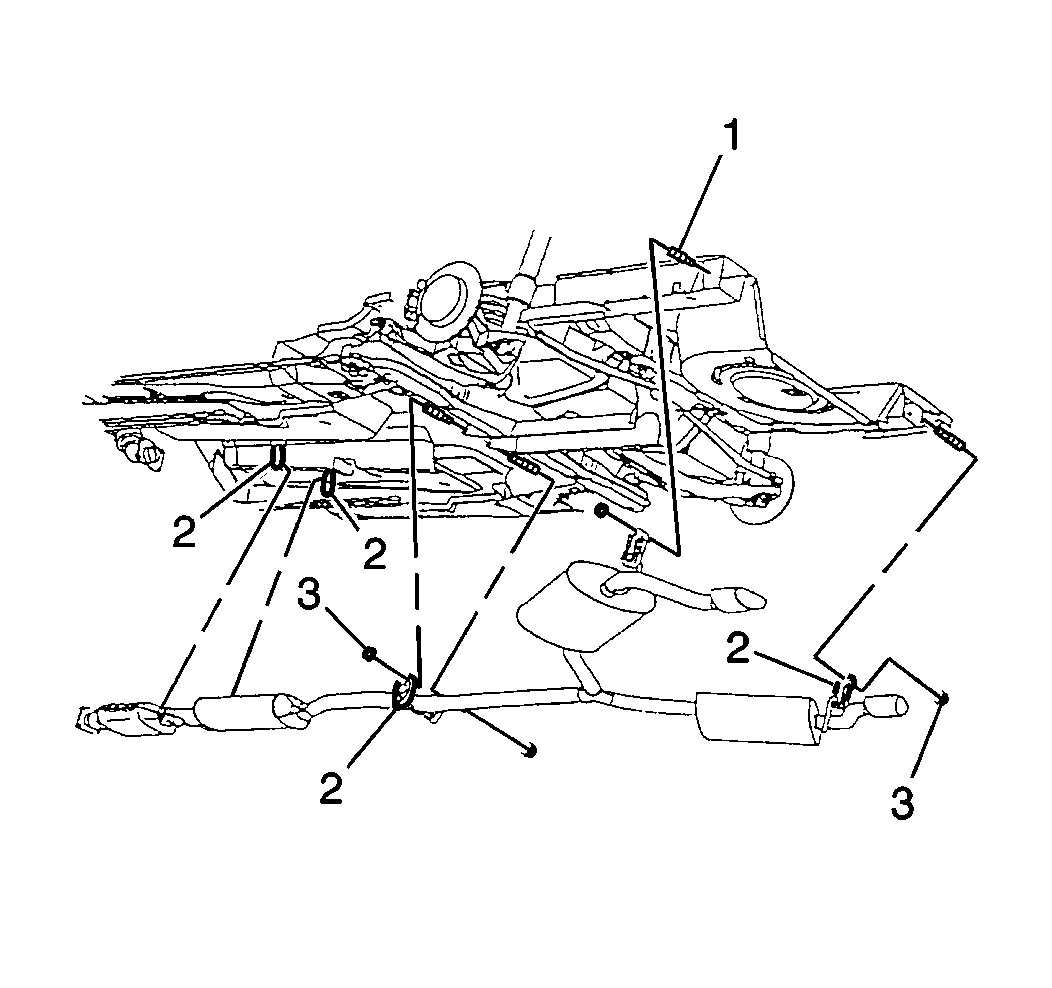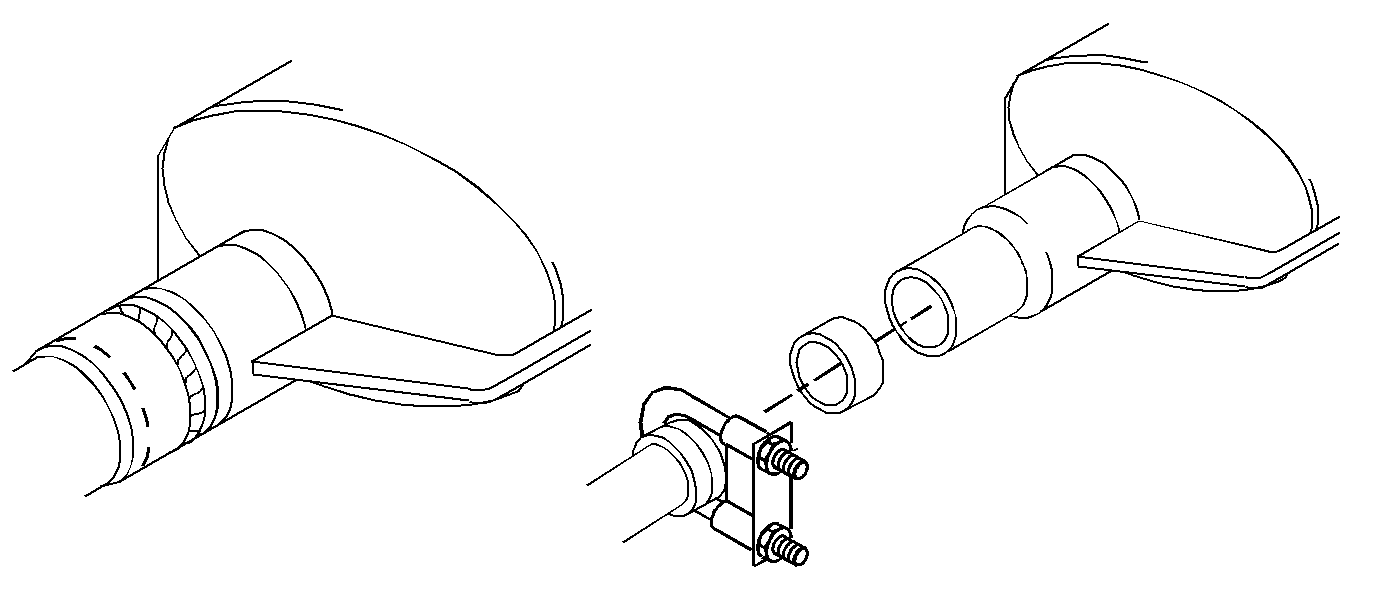The L47 Engine Exhaust System
The exhaust system on the L47 engine incorporates (in order from front
to rear):
| • | An exhaust manifold rear pipe (Y pipe) |
The exhaust crossover pipe is attached to the front and rear exhaust
manifolds. A joint coupling, using a round graphite impregnated seal, connects
the rear exhaust manifold pipe to the inlet of the catalytic converter. The
rear exhaust manifold pipe contains a flex joint. The flex joint replaces
the exhaust springs commonly used with bolts that attach the rear exhaust
pipe to the manifold and crossover pipe. The intermediate pipe assembly is
welded to the converter outlet.
The L36 or L67 Exhaust System
The exhaust system on the L67 engine incorporates (in order from the
front to the rear):
| • | An exhaust manifold front pipe |
| • | A three way oxidation catalytic converter |
The exhaust manifold front pipe is welded to the catalytic converter
therefore, they are serviced as one unit. The exhaust crossover pipe attaches
to the front and the rear exhaust manifolds.
All exhaust pipe to exhaust manifold connections are of the ball joint
type to allow angular movement for engine roll motion.
Catalytic Converter
The catalytic converter is an emission control device added to the exhaust
system on unleaded fuel gasoline engine vehicles to reduce pollutants from
the exhaust gas stream. The catalyst in the monolith converter is serviced
by replacement only. the converter is the single bed type.
Notice: In order to avoid damage to the catalyst, use unleaded fuel only.
The catalytic converter also contains a second oxygen sensor which is
located near the outlet of the converter.
Heat Shields
The Oldsmobile with a L47 engine and the Buick with the L67 engine use
heat shields that are attached to the underside of the body. They are there
to reflect the heat of the exhaust system away from the body.
Caution: Damage may occur to related components if a removed heatshield is not
reinstalled.
The post catalytic converter oxygen sensor is protected by a heat shield
which is attached to the underbody of the vehicle.
Exhaust System Hangers


The exhaust systems are
supported by free-hanging rubber mountings (2) which permit some
movement of the exhaust system. The free-hanging rubber mountings do not permit
transfer of noise and vibration into the passenger compartment.
Annoying rattles and noise vibrations in the exhaust system can be caused
by misalignment of parts or retention of heat shields. When aligning the system,
leave all of the bolts or nuts loose until all of the parts are properly aligned.
Then, tighten them working from the front to the rear.
Tighten them working from the front to the rear.
Tighten them working from the front to the rear.
Notice: When jacking or lifting the vehicle from the frame side rails, be certain
that the lift pads do not contact the catalytic converter. This may damage
the converter.
Periodic maintenance of the exhaust system is not required; however,
if the car is raised for other service, it is advisable to check the general
condition of the catalytic converter, pipes, and mufflers.
On-Vehicle Service
Notice: If there is any mis-positioning, incorrect installation,
or failure of components in the brake system pipes, hoses, or wheel cylinders,
check for brake damage. The exhaust system components must have adequate clearance
from the floor pan to avoid overheating of the floor pan, damage to the passenger
compartment carpets and damage to items in the luggage compartments.
When installing exhaust parts, make sure there is enough
clearance between the hot exhaust parts and the pipes and hoses. The pipes
and hoses could be damaged by the heat.
Inspect the following components for damage:
| • | The complete exhaust system |
Damage could include any of the following conditions:
These conditions could permit exhaust fumes to seep into the trunk or
passenger compartment. Any damaged areas must be corrected immediately.
Exhaust Component Replacement
The exhaust system is welded and can be serviced by the following components:
| • | Exhaust manifold rear pipe (Y pipe) |
| • | Resonator/ intemediate pipe |
| • | Muffler and tail pipe assembly |
Follow the below guidlines when servicing this system:

| • | Make the cuts in the specified
areas. |
| • | When installing a replacement converter to an existing exhaust
or intermediate pipe/resonator assembly, remove the remaining portions of
the converter inlet/outlet pipe. |
| | Caution: If the converter and adjacent pipe are replaced, a sleeve (or spacer)
that is supplied with the pipe must be used or a poor fit may result. Bodily
injury may occur if exhaust gases are released under the vehicle.
|
| • | Use a sleeve (or spacer), that is supplied with the pipe, any time the
converter and adjacent pipes are replaced. |
Exhaust System Alignment
Exhaust system hangers minimize noise transfer through hangers. If the
system contacts the body, or the hanger is restricted, vibration and noise
can be transmitted into the vehicle.
Position the clamps and the insulators so that the hangers are vertical
when the exhaust system is at operating temperature. The support brackets
should be horizontal.
If the pipes need to be repositioned, heat may be used in front of rear
suspension. The support brackets should be horizontal. Do not touch the pipes
while they are hot. Do not use an acetylene torch neat the fuel tank.
After the hangers and/or the repositioning pipes have been adjusted,
check the entire system for adequate clearance to frame members and floor
plan, minimum 15 mm (5/8 inch). Tighten all of the clamps according to specified
torque's. Clearance is needed to avoid possible damage to the passenger compartment
carpets. Distribute the weight of the exhaust system evenly on all brackets
and hangers as indicated by an equal deflection at each hanger.
Some vehicles may exhibit exhaust system misalignment due to an improper
installation process of the front pipe (L67). When installed low in the assembly,
the front pipe (L67) can pull the exhaust system forward and hit part of the
body. The pipes being installed low in the assembly can also make the exhaust
system close enough to the body that when the vehicle goes over a bump, it
may contact the body. To properly correct the condition, reinstall the rear
pipe based upon the on-vehicle service procedure. The exhaust system should
move into proper alignment. Refer to
Exhaust System Clearances
.
Crossover Exhaust Pipe
Refer to
Exhaust Crossover Replacement
in Engine Mechanical
for the on-vehicle service of the crossover pipe for the L47 and the L67.



